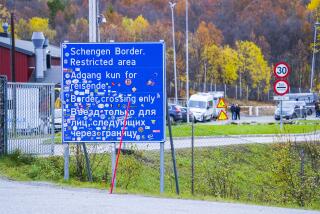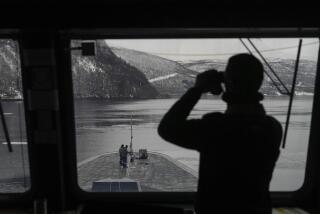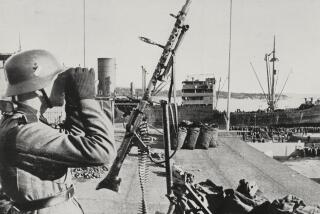Both Sides Stay Cool on Soviet-Norway Border
- Share via
SVANVIK, Norway — A showboating Soviet patrol boat, moving at high speed, ran aground on the Norwegian side of the Pasvikely River border the other day, leaving itself embarrassingly high and dry--with the potential for an awkward international incident.
Norwegian officials recalled the “Whiskey-on-the-rocks” incident in 1981 when a Whiskey-class Soviet submarine was grounded inside Swedish waters near a sensitive naval base, much to the chagrin of the Soviet navy.
But in the more recent episode, the Soviet dilemma was soon solved: The Norwegians allowed another patrol boat from the Russian side of the wide river to enter their waters and pull the craft free.
At the next regular meeting of border officials from the two countries, the Soviet member quietly apologized to his Norwegian counterpart, and the matter was dropped.
That’s the way they cooperate up here in the northeastern corner of Norway, far north of the Arctic Circle, where Norway maintains a series of guard posts like Svanvik to keep an eye on its neighbor.
Soviet Military Complex
For just across the border from this Western Alliance nation lies the Kola Peninsula, the single most important military, naval and missile complex in the Soviet Union.
The Soviet frontier begins in the south on the Gulf of Finland and runs north for hundreds of miles along the Finnish-Soviet border. Of the last 121 miles, where the Soviet Union then shares its frontier with Norway, most of the border is along the Pasvikely River, which ultimately ends in the Barents Sea.
Along the Pasvikely are six power stations, three Norwegian and three Soviet. A couple of Norwegian military posts actually buy their electricity from the Soviets. The Norwegians guard the border with outposts staffed by a 150-man company of the 550-man battalion that garrisons the region. They share the wilderness with reindeer and the occasional brown bear.
Patrol craft daily skim up and down the river, carefully navigating on the Norwegian side.
On a recent trip aboard a 21-foot patrol boat from Svanvik, the battalion commander, a trim, beret-clad lieutenant colonel of the Norwegian army, spoke over the roar of the hydrojet engines pushing the boat near 40 m.p.h. and pointed out the yellow buoys that mark the watery frontier.
“We are now just two yards from the Russian border,” he remarked.
The river occasionally widens into lake-like stretches, the Soviet side marked with striped border poles in red and green, the colors of the KGB secret police, which guards the frontier. Norwegian border poles are yellow and black.
“We haven’t had any problem with the Russians up here,” said the colonel, who asked not to be identified. “I meet with them regularly and sort out any problems that come up. Our own boys are mostly conscripts, but they are alert and seem to like the duty here along the frontier.
“I think the Russian boat that grounded was just showing off for us,” he continued. “The skipper was doing about 40 knots, and I’m sure he’s regretting it now.”
“Each side prides itself on having faster boats. The border runs not down the center of the river but along the deepest part of the channel. This is continually shifting, so the border moves too.”
The main town on the Soviet side is called Nikel, named for the metal that is extracted from the ground in that region. Unfortunately, the three tall smokestacks from the smelter have rained down acid on the pine, birch and spruce forests that lie downwind, leaving them dying from pollution.
On their side of the border, the Soviets have erected a 9-foot-high wire fence, with earth ramparts and sensors.
“That fence stretches all around the northern coast across Siberia to the Pacific Ocean,” said the colonel.
However, there are no barriers on the Norwegian side, which can create a problem with tourists.
“They are free to go out in the river in their boats,” said the officer. “But sometimes they cross over to the Russian side to have their picture taken next to the Soviet border poles.
“Occasionally they rip off the Soviet medallion from the pole. And recently, one man--a misguided patriot, I think--brought back the whole 6-foot pole to our side and burned it.
“He got 30 days in jail, and the Russians got an apology.”
The only border crossing is near Kirkenes, a town on the Pasvikely River with an iron smelter to process the ore that is mined in this remote region. Kirkenes has the look of small communities in northern Minnesota or Montana.
Deputy Mayor Halvard Kvamsdal, an affable man who runs the town’s only government liquor store, said: “We don’t see the Russians as a threat up here. We have some cross-border cultural and sporting events, chess games and skiing.”
And most Norwegians are covetous of the cheap vodka obtainable across the border, since alcohol carries a high tax in Norway.
From time to time, the town drunk stumbles up to the Soviet border post and offers to buy vodka but is quickly turned back. Otherwise, there isn’t much excitement.
The only real danger, as perceived here, comes through mishaps. The townspeople all remember the dark afternoon in 1985 when a runaway Soviet missile fired from the Kola Peninsula streaked across the sky before plunging into a frozen lake in Finland to the south.
More to Read
Sign up for Essential California
The most important California stories and recommendations in your inbox every morning.
You may occasionally receive promotional content from the Los Angeles Times.










